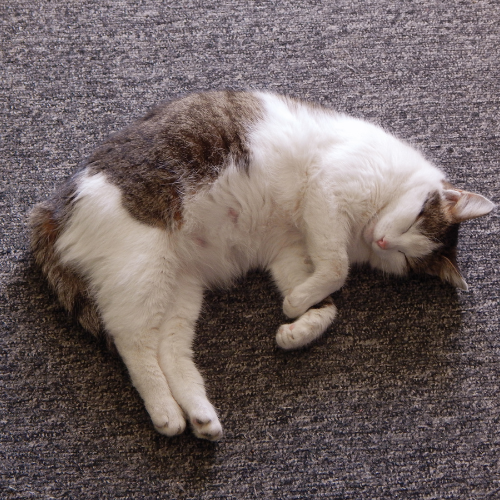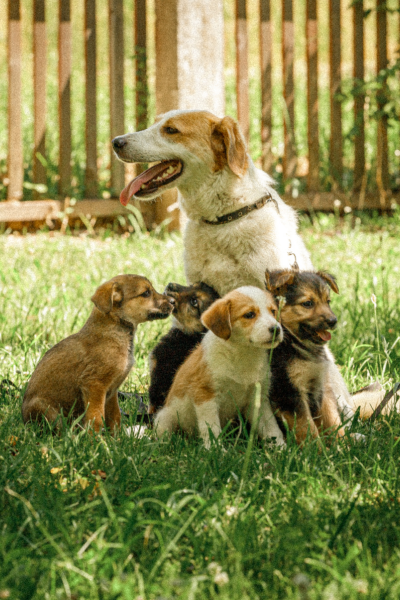Pregnancy and Birthing in Cats and Dogs
What is the length of pregnancy?
The length of pregnancy, also referred to as the gestation period, is approximately 61-65 days (average of 63 days) in a cat or dog.
How will I know if my furbaby is pregnant?
To determine if your furbaby is pregnant, an abdominal palpation by your veterinarian is usually required. Your veterinarian may recommend performing an abdominal ultrasound to confirm pregnancy and to determine the vitality of the pups/ kitten. Taking a radiograph during the late stage of gestation (approximately day 55 after ovulation) can assist in approximating the size of the litter. Doing a foetal count may be beneficial in facilitating treatment in case of foetal retention and in allowing for early intervention in case of difficulty in birthing (dystocia).
What to expect during pregnancy?
Throughout your furbaby’s pregnancy, expect to see lots of changes in your furbaby’s body. At about 4 ƒweeks of pregnancy, the mother’s abdomen may start to swell rapidly and her mammary glands will start developing. Some may present with more obvious belly bulging than others. Milk production will usually start about 7 days before birthing. She will appear to be more hungry and will be less active.
In the last 24 hours of pregnancy, you will expect to observe nesting behaviours. Most mothers will start seeking more attention and appear to be more sooky at this point. Her body temperature will also drop by about 1°c on the day of birthing. Therefore, monitoring her body temperature twice daily starting the week before her expected due date can assist you in establishing her birthing day.


What should I expect during labour?
The mother will usually show signs of restlessness, panting and pacing. Clear and watery vaginal discharge is normal at this stage. This stage can last between 12 to 24 hours.
Once you start seeing contractions on her abdomen, it is usually a sign that the first baby is on its way! Typically, these contractions should not last more than 1-2 hours between the birth of each puppies or kittens (normally this will take between 30 to 60 minutes). The entire delivery process may take anywhere from one hour to more than 24 hours. Throughout this period, the mother may continue to pant and appear restless. Anorexia is also common during this time. Vaginal discharge ranging from clear, bloody to green can be normal.
Once all the foetuses have been delivered, the mother will usually expel her placenta. Some mothers can also expel birthing materials in between births of her babies. Most mothers will ingest the placenta or birth sacs (the sac that surrounds the foetus).
What can I do to help during labour?
Most mothers will not need your help. Kittens and puppies can be born head or tail first. Once the baby is born, the mother should instinctively remove the birth sac and stimulate breathing by licking the baby. If this does not occur within a few minutes of birth, you may need to take over by removing a sac and using a dry cloth to wipe the baby to stimulate breathing. Once the baby starts to move around and cry, return it to the mother.
When to seek help during labour?
Do not hesitate to contact your veterinarian if the following complications occur:
- Dystocia (difficulty birthing)
- The inability to dislodge a baby from the birth canal, lasting for more than 10 minutes
- Contractions extending beyond 4 hours with no kittens/ puppies being born
- Birthing time that extends more than 5 hours between the last birth and the expected birth (this is when a foetal count prior to birth is helpful!)
- Retained placenta
- Abnormal, odorous or excessive bloody discharge from the birth canal
- Stillbirths
What are some common pregnancy complications?
Gestational diabetes
- This condition occurs during gestation/ pregnancy and is a result of the failure to produce or utilise insulin. It is usually short lasting and resolves soon after birthing. However, gestational diabetes can pose a serious threat to the mother and her babies if left untreated.
- Symptoms include excessive drinking and urination of large amounts of clear urine, weight loss despite excessive appetite and extreme lethargy.
- Treatment usually involves diligent blood glucose monitoring and administration of insulin as directed by a veterinarian.
Pre- eclampsia or milk fever
- This occurs when the mother’s blood calcium level falls too low during pregnancy or during nursing.
- Most mothers with milk fever can become restless, agitated and disoriented. You may also start seeing signs of stiffness in gait and panting. This is an emergency situation and the mother should be presented to a veterinarian for treatment.
- The treatment usually involves the supplementation of calcium under veterinary supervision as excessive calcium intake can do more harm than good.
Pre- eclampsia or milk fever
- This occurs when the mother’s blood calcium level falls too low during pregnancy or during nursing.
- Most mothers with milk fever can become restless, agitated and disoriented. You may also start seeing signs of stiffness in gait and panting. This is an emergency situation and the mother should be presented to a veterinarian for treatment.
- The treatment usually involves the supplementation of calcium under veterinary supervision as excessive calcium intake can do more harm than good.
Retained placenta
- The placenta is normally passed within 15 minutes after the birth of each neonate or towards the end of the birthing process. It is often difficult to estimate the number of placentas being expelled as they are mostly eaten by the bitch/ queen.
- It is important to closely monitor your furbaby after birthing for signs of placenta retention such as vomiting, anorexia, lethargy or abnormal vaginal discharge (often green discoloured discharge). Blood tests, vaginal cytology, radiographs and abdominal ultrasound may be recommended to help diagnose retained placenta.
- Usually, administration of oxytocin will stimulate uterine contractions to help expel the retained placenta. Rarely, surgical removal or ovariohysterectomy may be required.
Mastitis (inflammation of the mammary glands)
- The mammary glands start to enlarge towards the end of pregnancy. Mastitis is a common condition during the first two weeks of nursing. Mastitis can happen in a few different ways. It can occur if the mother has a systemic infection (sepsis), resulting in infection of her mammary glands through her own circulating bloodstream. A contaminated environment, injury of a teat(s) and overuse of a single mammary gland can also predispose to mastitis.
- Symptoms of mastitis include reddened, hot, swollen and painful nipple(s). The mother can also be presented with signs of lethargy and inappetence.
- To prevent mastitis, examine the teats daily for any signs of trauma. Make sure that the neonate’s nails are nicely trimmed. Check the environment and teats to make sure that they are clean at all times. Encourage suckling from all the teats to reduce overuse of a particular gland. Occasionally, mastitis can be so bad that it prevents suckling. In such cases, nutritional supplementation for the puppies/ kittens is required. It is always a good idea to have your furbaby checked out by a veterinarian if you suspect that your furbaby has mastitis.
What can I do to ensure a healthy mum and her babies?
Vaccinations and worming
- Before your furbaby gets pregnant, it is important to ensure that they are up to date with their vaccinations and worming. This immunity can be passed on to her babies to protect them from diseases that can result in congenital deformities or debilitating diseases.
Nutrition
- Optimal nutrition is vital in ensuring a healthy mum and her litter. Obesity, unfortunately, is the most common malnutrition in reproducing cats and dogs. Obesity leads to decreased fertility, increased risk of dystocia, decreased milk production and therefore, a less viable litter. Any obese animals should lose weight before conceiving.
- During the first two trimesters (up to 40 days of gestation), the nutritional requirement of a pregnant mother is approximately the same as a young adult dog. It is important not to overfeed or underfeed a mother during this time. Monitoring weight and body condition score daily is essential to help adjust the amount of food you are feeding your expecting furbaby.
- During the third trimester (around 40 days of gestation), the foetuses will develop rapidly and place a massive burden on the mother. Her nutritional requirement may increase by 30 to 60% of her normal intake depending on the size of her litter. This is the time to start feeding your furbaby with a high quality puppy food (a small or medium breed puppy food is ideal as they contain the right ratios of calcium and phosphorus to support foetal growth). Multiple, small meals is the best at this time since the foetuses have taken up most of the abdominal space, leaving little space for the gastrointestinal tract to fill with food.
- Throughout lactation, continue feeding the mother a high quality puppy food. Lactation increases the energy demand more than during a mother’s last trimester. Again, monitoring the weight and body condition score of the mother is pivotal at this stage. Under-feeding can cause severe malnutrition to the mother. Meanwhile, over-feeding can result in overproduction of milk which can predispose to mastitis, especially in mothers with a smaller litter size. As you begin to wean the babies off milk (around 4 weeks after birth), start to restrict the mothers food intake to taper off her milk production. You should expect to wean the kitten or puppies off milk by around eight weeks old.
Veterinary health checks
- It is important to present your furbaby to a veterinarian for a check-up before getting pregnant, when diagnosing pregnancy and after birthing. More regular check-ups may be indicated if you are worried about your furbaby’s progress throughout the pregnancy. It may also be a good idea to present the neonates together with their mother for a health check after birth. Your puppies and kittens will be ready for their first vaccination at 6-8 weeks of life.
Congratulations if your furbaby is expecting, you will have lots of grand-furchild to look forward to! Having to plan the pregnancy and go through birthing with your furbaby can be exhilarating and nerve-wrecking at the same time, especially if this is the first time! We are committed to helping you and your furbaby go through her pregnancy and birthing process successfully in the least stressful way possible.


